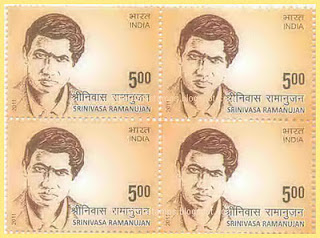India Post released New stamp for Srinivasa Ramanujam in his 125th birth anniversary. Stamp Released by our honorable Prime Minister Dr. Manmohan Singh in Chennai also declared December 22, the birthday of Ramanujan, as ‘National Mathematics Day.’
Srinivasa Iyengar Ramanujan ( 22 December 1887 – 26 April 1920 ) was an Indian mathematician, Born in Erode, Tamil Nadu, India, to a poor Brahmin family, Ramanujan first encountered formal mathematics at age10. He demonstrated a natural ability, and was given books on advanced trigonometry written by S. L. Loney. He mastered them by age 12, and even discovered theorems of his own, including independently re-discovering Euler's identity. He demonstrated unusual mathematical skills at school, winning accolades and awards. By 17, Ramanujan conducted his own mathematical research on Bernoulli numbers and the Euler–Mascheroni constant. He received a scholarship to study at Government College in Kumbakonam, but lost it when he failed his non-mathematical coursework.
He joined another college to pursue independent mathematical research, working as a clerk in the Accountant-General's office at the Madras Port Trust Office to support himself. In 1912–1913, he sent samples of his theorems to three academics at the University of Cambridge. Only Hardy recognised the brilliance of his work, subsequently inviting Ramanujan to visit and work with him at Cambridge. He became a Fellow of the Royal Society and a Fellow of Trinity College, Cambridge, dying of illness, malnutrition and possibly liver infection in 1920 at the age of 32.
During his short lifetime, Ramanujan independently compiled nearly 3900 results (mostly identities and equations).Although a small number of these results were actually false and some were already known, most of his claims have now been proven correct. He stated results that were both original and highly unconventional, such as the Ramanujan prime and the Ramanujan theta function, and these have inspired a vast amount of further research. However, the mathematical mainstream has been rather slow in absorbing some of his major discoveries. The Ramanujan Journal, an international publication, was launched to publish work in all areas of mathematics influenced by his work.

No comments:
Post a Comment